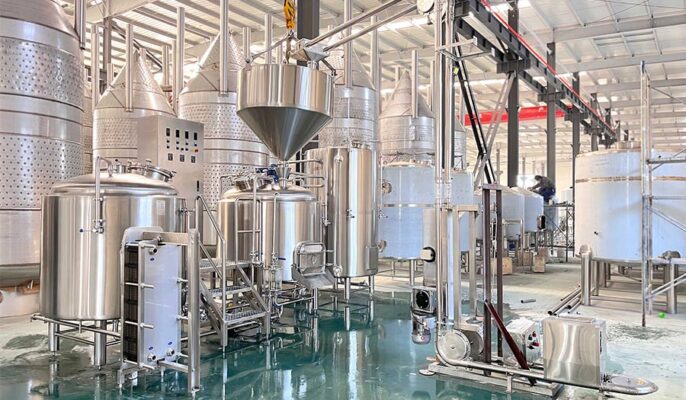As the brewing industry continues to evolve, process optimization and efficiency improvements have become top priorities for many beer companies around the world. High-gravity brewing is one way to achieve these goals. High-gravity brewing can significantly increase brewery capacity without having to invest in a brewhouse, tank, or filter capacity.
What is high gravity brewing?
High gravity brewing is a term that refers to the process of preparing a strong wort with a high original gravity, intended to produce a high alcohol content beer. Normal wort strength is in the 10°–13° Plato range, producing beer with an alcohol by volume (ABV) of 4%–6%. See Plato’s gravity scale. High gravity worts are generally considered to be in the 14°–17°Plato range and will produce a beer of 6%–8% ABV. Very high gravity worts have a solids content greater than 17°Plato and an alcohol content greater than 8%.

Factors to consider when brewing in high gravity
Dilution water
Extract brewers are familiar with dilution; every extract brewer boils the concentrated wort and transfers the wort to a fermenter filled with several liters of water to speed up the cooling of the wort. Add more water later to bring the volume up to final batch size. The reason for the low dissolved oxygen concentration in the released water is that packaged beer, unlike most alcoholic beverages, is unstable. One of the main factors causing this instability is oxygen.
Style restrictions
High-strength brewing is only practical when producing medium to medium-strength beers. Strong beers like barleywine and doppock depend on all the gravity the brewer can get from the malt, and diluting these beers would be counterproductive. You can also only put a certain amount of grain in the mash tun, so you have to produce smaller batches, the first batch of grain after filtration. Furthermore, the limited alcohol tolerance of S. cerevisiae means that it is impossible to brew high strength beers (e.g., >12% alcohol [v/v]) and dilute them to achieve a high alcohol content in the finished beer. So, I recommend that high-strength dilution brewing be suitable for the production of finished beers with a target alcohol content of up to 8% (v/v).
Dilution limit
If you’ve ever visited a large commercial brewery, you’ve tasted a sample of their undiluted beer. You may be surprised by its taste and properties. Beer can only be diluted to a certain point before it starts to taste watered down. A general rule of thumb in the beer industry is that beer can be diluted up to 30-40%. If this range to be the practical limit (and the extreme that most of us would like to avoid), it’s easy to imagine that adding less water would have little effect on the final product.
Other factors
High-strength brewing requires more of each ingredient to match the characteristics of a brewed beer—more malt, more hops, and more yeast. High-gravity brewing also brings new problems to brewers. Studies have shown that high-strength beers, whether diluted or not, have poorer foam retention than normal-strength beers.
High gravity environments can reduce hop use and cause some yeast strains to perform . Color adjustments may also be needed. , brewers can address these issues through recipe tweaks. The water used for dilution is also very important, especially since it is added after fermentation.
Benefits of High Gravity Brewing
- Efficiency: High-gravity brewing can improve the efficiency of the brewery because a large amount of high-alcohol beer can be produced in a single batch.
- Save time and resources: Brewing small batches of high-strength beer saves time, energy and resources (e.g. water, ingredients, cleaning).
- Flexibility: High gravity brewing allows you to produce a range of beer styles with different alcohol levels in the same batch.
- Reduced storage space: Producing concentrated wort reduces the volume that needs to be stored in the fermenter and throughout the brewing process.
High Gravity Brewing Challenge
- Brewery equipment pressure: Higher sugar concentrations will put pressure on brewery equipment, which can lead to problems such as blockage, increased wear and difficulty in transferring and handling thicker wort.
- Yeast management: High-concentration wort can cause stress on yeast cells, which may lead to incomplete fermentation, off-flavors, and other fermentation-related problems.
- Flavor and Complexity: High-strength beers may have different flavor profiles and must more aging or conditioning to mellow harsh alcoholic flavors.
- Recipe change: The recipe and process need to be adjusted to ensure that the resulting beer is balanced and not alcoholic or sweet.
- Nutritional imbalance: Yeast needs a balanced nutritional environment for optimal fermentation, and high specific gravity wort may affect this balance.
- Quality Control: High-strength brewing requires precise control of the brewing process to ensure consistency and quality from batch to batch.
Advantages of High Gravity Brewing
Over time, high-strength brewing has been introduced by breweries around the world. This procedure uses wort (unfermented beer) with a higher than normal concentration and so needs to be diluted with treated water (usually deoxygenated) to the desired concentration or alcoholic strength in later stages of processing. By reducing the brewery’s water usage, increased production demands can be met without the need to expand existing brewing, fermentation and storage facilities.
- Improve fermentation rate and final fermentation rate
- High quality yeast vitality and vitality
- Reduced production time, including new yeast strains
- More effective beer stabilization and filtration
- Improve beer quality and stability

Disadvantages of High Gravity Brewing
The high-gravity brewing process also has many disadvantages. Because the mash is more concentrated, the brewhouse’s material efficiency (how it extracts soluble materials from the malt and other grains used in the process) is reduced. Additionally, hop use is reduced during the wort kettle boiling process. The resulting diluted beer foam becomes less stable and the beer flavor changes. Yeast performance is affected by high specific gravity worts due to higher wort concentration and increased ethanol production.
High Gravity Brewing Considerations
- Brewery Equipment Assessment: Test whether your current brewery equipment can meet the needs of high-gravity brewing, or if modifications/upgrades are needed.
- Yeast management: Develop a robust yeast management strategy to cope with the challenges of higher gravity wort.
- Recipe Development: Recipes are designed to achieve the desired flavor profile and alcohol content while maintaining balance.
- Process control: Tool strict quality control measures to ensure consistent and high-quality results.
- Training: Make sure your brewing team is knowledgeable and trained in the technical ins and outs of high-gravity brewing.
High concentration brewing process
High-strength beer uses the process of preparing high-strength wort to produce beer with higher alcohol content. Wort is the term used to describe unfermented beer, or in other words, beer before fermentation. Before any adjustments are made, an original gravity measurement of the unfermented liquid or wort will be taken. Raw gravimetry measures the amount of dissolved sugar in beer that can be converted to alcohol during fermentation. A solution with more sugar means more alcohol. The original gravity of most beers is 10°–13° Plato. The brewer will then make adjustments by adding more grains, malt, or sugar, depending on the style of beer they are producing.
Is high gravity brewing suitable for small breweries?
For smaller producers, wort dilution is easier to put in place than beer dilution and is much less expensive. So there’s no problem with diluting the wort on brew day. In fact, it’s about getting your gravity over about 10 to 30 percent, diluted, so that you can be very time efficient, more raw material efficient, and you can fill your tank as much as possible. But beer dilution is impossible for small breweries because the equipment cost of dissolved oxygen meters and DAL plants is quite high. Nothing against beer dilution either, it’s about efficiency and brewing the best beer possible. Both are compatible.




